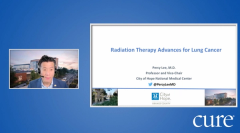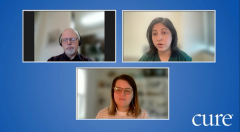
Educated Patient® Lung Cancer Summit Advancements in SCLC Presentation: April 29, 2023
Watch Dr. Ravi Salgia, from City of Hope, discuss advancements in small cell lung cancer during the CURE® Educated Patient® Lung Cancer Summit.
Episodes in this series

For patients with small cell lung cancer, new treatments are improving outcomes for patients with the disease, while ongoing trials are showing promise for even better survival in the future — especially for patients whose disease has spread to other parts of the body. However, much work is still needed.
“In small cell lung cancer, early diagnosis can lead to a potential cure, but extensive disease is still very difficult to treat,” said Dr. Ravi Salgia, professor and chair in the Department of Medical Oncology at City of Hope. “Immunotherapy has now been approved, second-line therapy has also advanced, and novel therapies need to be tested more rapidly.”
Salgia recently discussed updates in small cell lung cancer at CURE®’s Educated Patient® Lung Cancer Summit.
The treatment of SCLC depends on whether a patient has limited disease, meaning that the cancer has not spread, or extensive disease, when the cancer metastasized to another part of the body, such as the opposite lung, lymph nodes or other organs.
If patients with limited disease are eligible, they’ll often undergo surgery first to remove the cancer. Then, they will typically be treated with a chemotherapy combination and radiation.
“There are no observed benefits of (chemotherapy) for more than four to six cycles,” Salgia said. “Radiation therapy does improve local control of disease and increases two- or three-year survival by 5%. (However, it has) increased toxicity in some studies, but is most effective when given early with concomitant chemotherapy.”
For patients with metastatic or extensive disease, Salgia said that he is “very excited” about the upfront drug combination of Tecentriq (atezolizumab) — an immunotherapy agent — plus Imfinzi (durvalumab) and chemotherapy, that led to improved overall survival (time from treatment until death of any cause) and progression-free survival (time from treatment until death or disease worsens).
Of note, for patients whose cancer spread to the brain, chemotherapy and immunotherapy agents tend to penetrate into the brain, though patients may also discuss the use of stereotactic radiosurgery, a type of radiation treatment that uses very precise radiation beams to treat tumors.
Other combined therapies available for this patient population include:
- Tecentriq plus carboplatin and etoposide (chemotherapy agents)
- Imfinzi plus cisplatin/carboplatin and etoposide
- Cisplatin plus carboplatin plus etoposide
- Cisplatin plus carboplatin blue irinotecan
“Chemotherapy is pretty efficacious in small cell lung cancer. However, it doesn’t last for as long in extensive-stage disease,” Salgia said.
In the second-line setting, the Food and Drug Administration approved Zepzelca (lurbinectedin) for patients whose disease progressed on platinum-based chemotherapy.
“We know that the majority of patients do well initially with chemotherapy and immunotherapy. However, the tough part about extensive-disease small cell lung cancer is that there’s progression, so one has to consider second-line chemotherapy,” Salgia said. “That’s really influenced by the time to progression after first-line treatment and the extent of tumor regression.”
Salgia said that he strongly encourages eligible patients with relapsed or refractory small cell lung cancer to consider participation in a clinical trial, especially if they have sensitive disease, meaning that they experienced a relapse less than six months after completing their original treatment.
Ongoing trials are looking at immunotherapy, targeted therapies and chemotherapy combinations for these patients.
“There is a laundry list of various therapies that one can consider,” Salgia said. “And these are constantly changing as more data comes through.”
For more news on cancer updates, research and education, don’t forget to















